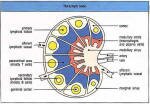
Non Hodgkin's Lymphoma
Cyberfamily
What is Lymphoma?
Lymphoma is a group of diseases of the lymphocytes. Lymphocytes are a type of white blood cell that circulates within the lymphatic system. Lymphoma is similar to leukaemia because it involves the white blood cells, but leukaemia involves the cells circulating in the blood. Lymphoma only involves the Lymphocytes, whereas Leukaemia can involve any of the various white blood cell types.
The primary place where lymphoma appears is in the lymph nodes themselves, including the spleen. But your lymph also circulates throughout all your body tissues and organs, therefore lymphoma can show up virtually anywhere. This includes the skin, brain, bones, and other places. You have probably heard that when other cancers spread outside their original location and into the lymph system the prognosis for the patient is extremely poor. The opposite is not true though. When lymphoma spreads outside the lymph system the prognosis is not affected by such a significant degree. In many cases it will have no affect on the prognosis. Click on the image below to see a larger view of what a lymph node looks like.
As you study the images on this page you will soon begin to recognize the names of many parts of the lymph node that correspond to the type of lymphoma a patient has.
Below is an overview of the entire lymphatic system, showing where many of the lymph nodes can be found.
Lymphoma is a very complex disease, and it comes in 32+ different varieties. But that number will increase in the years to come as they further refine the classification system and distinguish between different subsets of one-type. The first crucial distinction is between Hodgkin's Lymphoma, and Non-Hodgkin's Lymphoma.
Hodgkins's disease:
This type of lymphoma is quite rare. In general it affects young adults in their teens and twenties, and then older adults over 70. There are 5 varieties of Hodgkin's disease characterized by the presence of a special type of cell called a Reed Sternberg cell. Hodgkin's disease has a very high cure rate that runs around 85%. For more detailed information about Hodgkin's disease read the NCI summary of treatment and diagnosis here:
NCI Hodgkin's disease summary of diagnosis, treatment and prognosis
Hodgkin's disease pathology images
Non-Hodgkin's Lymphoma:
Our web site is dedicated to Non-Hodgkin's Lymphoma. NHL is approximately seven times more prevalent than Hodgkin's disease. It strikes about 65,000 North Americans each year. Non-Hodgkin's lymphoma is a far more complicated disease and consists of over 27 distinct varieties that are currently recognized. Therefore it requires an expert pathologist to ensure the correct diagnosis as the treatment for one type may be totally inappropriate for another type.
Broadly speaking Non-Hodgkin's Lymphoma can be divided into two main prognostic categories. The aggressive NHL's which are characterized by rapid growth and more often the presence of symptoms such as night sweats, weight loss, and fatigue. Approximately 50-70% of patients with an aggressive histology can be cured with conventional therapy.
Then there are the indolent, or slow growing NHL's. Although the indolent lymphomas are not currently curable, their indolent nature means they have an excellent prognosis for long term survival. Most patients can look forward to living with indolent lymphoma for 10-12 years or more. Patients often are not treated until they are symptomatic or major organs are at risk. This is called "watch and wait". When treatment is required there are many treatments available, and will generally begin with the mildest treatment possible that is consistent with the situation. When a relapse occurs a different treatment will often be used as drug resistance can become a problem.
Patients with indolent lymphoma usually undergo a pattern of treatment / remission / relapse with each remission generally being shorter than the previous one. Patients are usually encouraged to save the strongest treatments as long as possible for when they are needed the most. All patients should consider clinical trials because there are many new and promising treatments presently being investigated. Many of these treatments are much less toxic, and more easily tolerated. See our clinical trials page for additional information about finding trials.
For more detailed information on Non-Hodgkin's lymphoma read the NCI summary of treatment and diagnosis here:
NCI Non-Hodgkin's lymphoma summary of diagnosis, treatment and prognosis
Non-Hodgkin's Lymphoma pathology images
© 2006 NHL Cyberfamily All Rights Reserved.
Web design by Long2 Consulting
